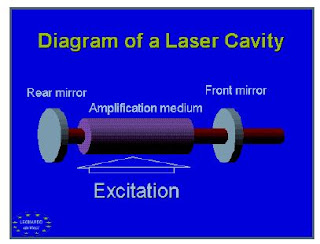LASER -Light Amplification by Stimulated Emission of Radiation
Main components of a Laser
1 Active medium,2 Excitation source/pump
3 Reflecting mirrors/ resonator
Solid State Lasers
•Ruby Laser: the first laser•Nd: YAG & Nd: Glass Lasers
•Tunable Solid State Lasers
•Alexandrite Laser
•Ti: Sapphire Laser
•Colour Center Lasers
•Fiber Lasers
Main properties of a Laser
Coherence: from phase correlation
DirectionalityHigh intensity: results from directionality
Monochromaticity: results in high temporal coherence
Short pulse duration
Types of Lasers
Several ways to classify lasers
Mode of operation:
ContinuousWave(CW)orPulsed
Active medium:-
1 Solid lasers-
2 Gas lasers-
3 Liquid lasers
4 Semiconductor lasers
Classification may be done on basis of other parameters
1 Gain of the laser medium
2 Power delivered by laser
3 Efficiency or
4 Applications
Solid State Laser
1 For historical reasons, solid-state lasers are lasers in which active ions in crystal or glass host materials are optically pumped to create a population inversion.2 Other types of lasers that employ solid-state gain media are semiconductor lasers and optical fiber lasers and amplifiers. Since these lasers employ very specialized technologies and design principles, they are usually treated separately from conventional bulk solid-state lasers.
3 Semiconductor or diode lasers are mostly electrically pumped (though in principle, optical pumping may be possible with some) Are versatile and provide a large range of average and peak power, pulse width, pulse repetition rate, and wavelength
The flexibility of solid-state lasers stems from the fact that:
• Different active materials can be selected with different gain, energy storage, and wavelength properties
• Output energy can be increased by adding amplifiers
• A large number of passive and active components are available to shape the spectral, temporal and spatial profile of the output beam
Solid State Laser: requirements
Requirements for Host material:
•Should not absorb light at laser wavelength
•Must possess sharp fluorescent lines, strong absorption bands, and high quantum efficiency
•Crystal should have good thermal conductivity
Problems with Host material:
o Most of excitation energy ends up as heat rather than light
o Excess heat damages the laser crystal
Active centresare ions from:Chromium (Cr), Neodymium (Nd), Titanium (Ti), Cerium (Ce), Erbium (Er), Holmium (Ho) and Cobalt (Co)
Chromium is active centre in Ruby and Alexandrite lasers
Neodymium is active centre in commonly used Nd: YAG laserSolid State Laser: requirements
Representative Solid State Laser
1 Ruby Laser
2 Nd:YAG Laser
3 Nd:Glass Laser
Tunable Solid State Lasers
•Alexandrite Laser
•Titanium-Sapphire Laser
•Colour-Centre Laser
Fiber Lasers
•Erbium in a Glass host
Ruby Laser: the first laser
Ruby laser rod:
A synthetic pink Ruby crystal (Al2O3doped with Cr3+ions)
Cr3+ions concentration: 0.05%, ==Approx 1.6*10^25ions per cubic meter.Ruby Laser: the first laser
The Al2O3(sapphire) host is hard, with high thermal conductivity, and transition metals can readily be incorporated substitutionally for the Al
•Active Centres(Cr3+ions) have a set of three energy
•Aluminum & Oxygen ions are inert
•Ruby crystal as cylindrical rod (4cm length 0.5 cm in diameter)
•Helical photographic flash lamp filled with Xenon.




No comments:
Post a Comment